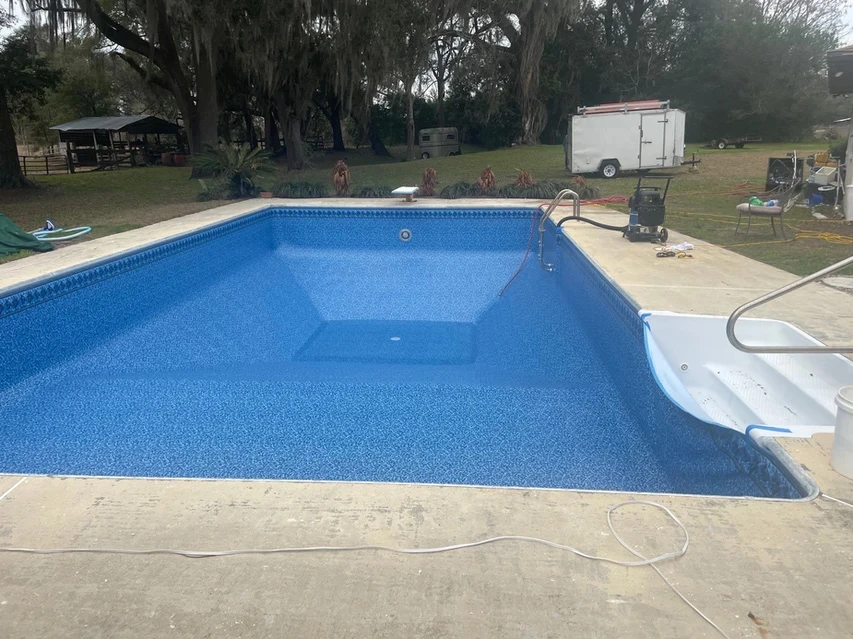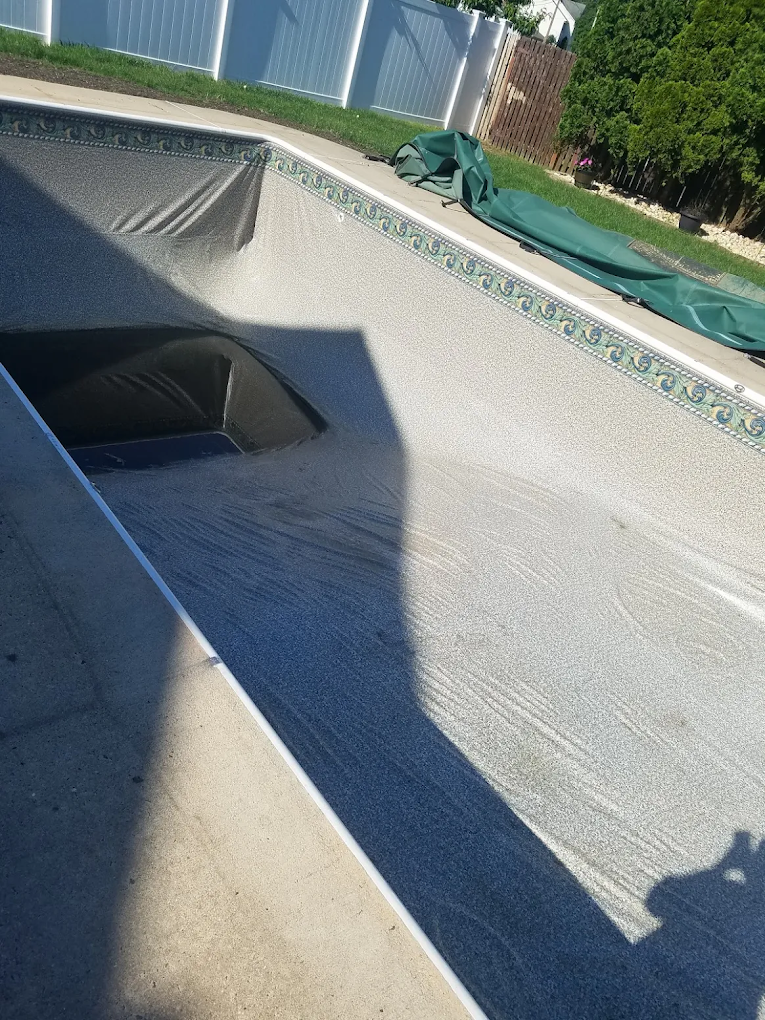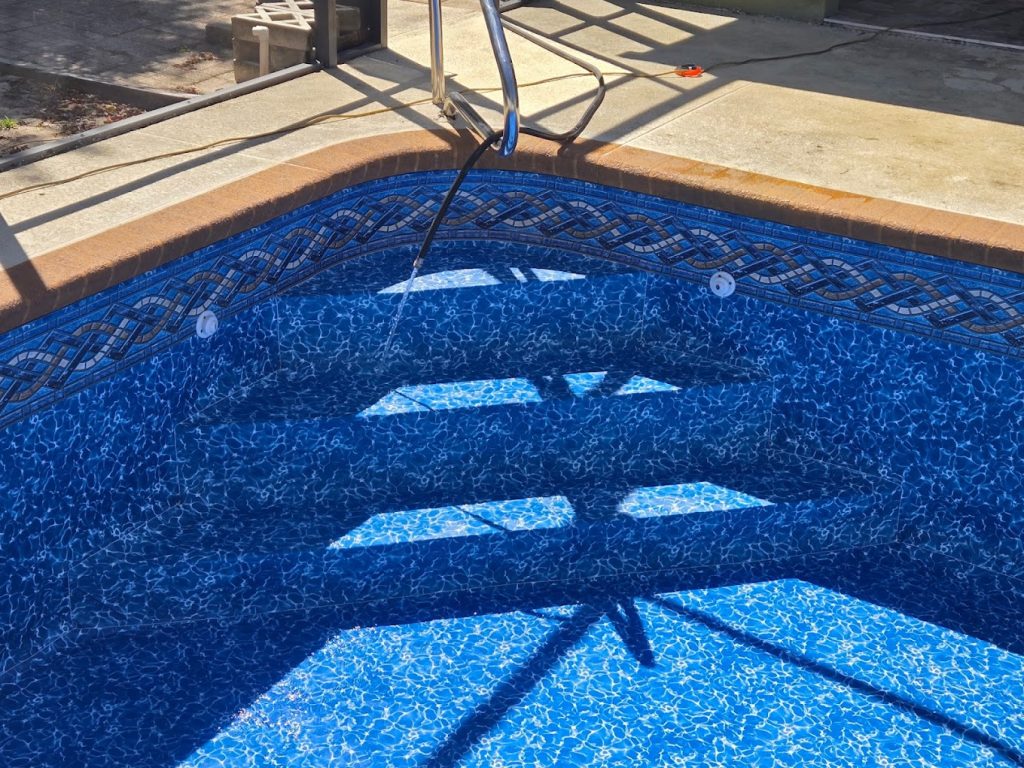If you’re a Rhode Island homeowner with an inground pool, you know our New England weather can be tough on vinyl liners. As the owner of RI Pool Pros with over 20 years of experience, I’ve seen it all when it comes to pool liner issues. I’m going to share honest, down-to-earth advice on inground pool liner repair in RI.
My goal is to help you protect your pool and avoid costly problems, And remember, at RI Pool Pros we stand by a 100% satisfaction guarantee – if anything isn’t right, we’ll make it right!
Signs Your Pool Liner Needs Repair

Not sure if your pool’s vinyl liner actually needs repair or replacement? Here are some tell-tale signs we see all the time across Rhode Island:
- Falling Water Level: Are you adding water to your pool more often than usual? A slow, steady drop in water level (beyond normal evaporation) can mean your liner has a leak or tear. Even a small pinhole or seam split can cause noticeable water loss over time.
- Visible Tears or Holes: This one’s obvious – if you see cracks, slits, or punctures in the vinyl, the liner needs attention. Small holes can sometimes be patched, but large tears (like around fittings or on steps) often require a new liner. Don’t ignore even minor damage, as it can spread.
- Wrinkles or Slippage: If the liner has started wrinkling, sagging, or coming out of the track (bead) at the top of the pool wall, it’s a sign of trouble. A liner that’s stretched or shifted won’t seal correctly and may indicate aging vinyl or a poor initial install.
- Fading, Brittle, or Cracking Vinyl: Over years of sun and chemical exposure, vinyl can lose its elasticity. If your liner’s color is extremely faded or it feels brittle and is cracking at the surface, it may be nearing the end of its life. You might see this at the waterline or in areas that were exposed to air over the winter.
- Water Under the Liner: In some cases, you might feel squishy spots on the pool floor or notice bubbles under the liner. This can mean water has gotten behind the liner (possibly from a leak) – a situation that can quickly worsen the liner’s condition if not fixed.
If you notice any of these signs, it’s wise to call a professional like us for an inspection. Catching liner problems early can mean the difference between a simple patch and a full replacement.
Why Fast Repair Matters

You might be tempted to let a small tear or leak go for a while, especially if swimming season is winding down. Don’t wait too long to address liner damage. Here’s why a quick repair is important:
- Prevent Major Leaks: What starts as a tiny pinhole can turn into a large tear in a hurry. Water pressure and movement will keep working on that weak spot. A delayed fix could result in your pool losing inches of water overnight.
- Avoid Structural Damage: When water leaks behind a vinyl liner, it doesn’t just harmlessly disappear. It can erode the sand or soil base beneath your pool, causing sinkholes or undermining the walls. In the worst cases, it might even damage your pool’s structure or surrounding patio. Fast repairs keep small issues from becoming costly headaches.
- Save Water and Chemicals: In Rhode Island, we pay for our water – and you’ve likely spent money balancing the pool chemicals. A leaking liner wastes both. By fixing leaks promptly, you’ll save on your water bill and chemical costs since you won’t be constantly refilling and re-balancing the pool.
- Protect Your Equipment: If your water level drops too low due to a leak, your skimmers can start sucking in air, which may damage your pool pump or filter. Maintaining the proper water level through timely repairs protects your equipment from running dry or overheating.
- Enjoy Peace of Mind: Finally, getting the liner fixed quickly means you can get back to enjoying your pool without worry. Rhode Island summers are short – you don’t want to lose swim time because of a preventable problem. A fast repair ensures your pool stays safe and swim-ready.
What Causes Pool Liner Damage in RI?

Rhode Island’s climate and local conditions can be tough on vinyl pool liners. Over the years, I’ve identified several common causes of liner damage that pool owners should be aware of:
- Harsh Winters & Ice Damage: Our cold winters are a major culprit. When the water in your pool or behind the liner freezes, it expands and can put tremendous pressure on the liner. Heavy ice sheets can form on the pool’s surface and then shift or crack, leading to tears in the vinyl. The freeze-thaw cycle (water freezing, then melting) is notorious for causing liner splits and seam failures. This is why proper winterization is so important in Rhode Island – to prevent ice damage to your liner.
- Bad Installation or Old Age: A liner that wasn’t installed quite right can fail early. We’ve seen liners that were a poor fit for the pool or not vacuumed in properly, resulting in wrinkles, folds, or stress points that eventually tear. Similarly, an older liner (10+ years) naturally becomes less flexible. Over time the vinyl can weaken at the seams or coping. If your liner was put in poorly or is well past its prime, damage is more likely to occur even with normal use.
- Kids, Pets, and Rough Use: We all love seeing kids having fun in the pool, but roughhousing can take a toll on the liner. Sharp or hard toys, dog claws, or even an adult with jagged jewelry can puncture the vinyl.
- Sun Exposure (UV Damage): Sunlight is another silent liner killer. Over the years, UV rays will cause the vinyl’s color to fade and can make the material more brittle. This is especially true at the waterline where the liner might be exposed to direct sun and air. In Rhode Island, we get plenty of sun in the summer, and if your pool is not covered in the off-season, that year-round exposure adds up. A sun-weakened liner can crack or tear more easily. (Using a pool cover when possible, and maintaining water chemistry, can slow this sun-related aging.)
- Chemical Imbalance: Pool chemicals need to be just right – too much chlorine or very low pH can damage your liner. High chlorine levels or super-chlorinating can bleach and dry out the vinyl. Likewise, if the pH drops too low (making the water acidic), it can literally start to eat away at the liner, causing it to become thin and frail. Always keep your water balanced (pH, alkalinity, sanitizer) not just for swimmer comfort, but to protect your pool surfaces. It’s a small effort that can add years to the life of your liner.
- Tree Roots and Debris: Believe it or not, tree roots can be a cause of liner damage, especially in older pools. If you have large trees near your pool in places like rural areas or even in neighborhoods of Warwick or East Providence, their roots can slowly migrate toward moisture. Vinyl liner pools (which usually have a sand or soil base) are a little more vulnerable to intruding roots. A root pressing under the liner can create a wear spot or puncture over time. Additionally, sharp debris like fallen branches or glass can cause instant damage if they find their way into the pool. Always clear out sharp objects and consider root barriers or removing problematic trees during a liner replacement.
Our Pool Liner Repair Process

At RI Pool Pros, our goal is to take the stress out of pool liner issues for you. We handle everything from the smallest patch to a full liner replacement with the same level of care and professionalism. Here’s how our repair process typically works when you call us:
- Initial Inspection & Leak Detection: First, we’ll schedule a visit to your pool. I’ll personally inspect the liner and the pool’s condition. If the leak location isn’t obvious, we use advanced leak detection methods, including electronic leak detectors or dye tests, to pinpoint where the liner is compromised. This step is crucial: sometimes what you think is a liner leak could be a plumbing issue, but we’ll figure it out for sure.
- Honest Assessment: Once we find the issue, we’ll give you an honest assessment of your options. If it’s a small tear and the liner is otherwise in good shape, we’ll recommend a repair patch. If the liner is failing in multiple spots or very old, we’ll explain why replacement is the safer bet. No hard sells, no gimmicks, we treat our customers like neighbors and want what’s best for you and your pool.
- Patching (if applicable): For straightforward liner repairs, we’ll often do it right then and there. We’ll clean the area, trim any loose vinyl, and apply a strong vinyl patch. Many minor repairs can be done without draining the pool, using adhesives that cure underwater. You might literally see me don a mask and hop in with a patch if needed! After patching, we test to ensure the leak is resolved.
- Liner Replacement (if needed): If a new liner is in order, we’ll walk you through the process and schedule it at a convenient time. Our team will help you choose a new liner pattern and brand (we offer a variety of choices from our trusted suppliers). Once you’ve picked the perfect liner, here’s what we do:
- Draining and Removal: We’ll pump out the pool water safely (usually we time this so it’s just before installation day). Then we carefully remove the old liner, cutting it out and hauling away the old vinyl for disposal.
- Surface Prep: With the old liner out, we inspect the pool walls and floor. We’ll fix up the sand/cement base if there are any divots or washouts, and smooth everything. We also often install new foam padding on the walls for a bit of added cushion and insulation (this helps the new liner last longer).
- Installing the New Liner: This is where experience really counts. We precisely fit the new liner into place, making sure the pattern lines up evenly. The liner’s bead gets locked into the track around the top edge. We use vacuum suction to pull the liner tight against the walls/floor, removing wrinkles before adding water. This step is key to a perfect fit.
- Refilling and Finishing: Once the new liner is set, we begin refilling the pool with water. For faster filling, we can truck in water if needed (especially common for big pools or if your well can’t handle filling). As the water goes in, we keep adjusting the liner to ensure it’s seating nicely. We’ll also replace face plates, gaskets, and return fittings with new ones, and reinstall the main drain cover, etc., so everything is sealed up. After filling, we remove the vacuums and do a final check for any issues.
- Chemical Balancing & Cleanup: After a replacement, we typically add initial chemicals (like startup algaecide or adjust pH) to get your water balanced. Then, we clean up the job site, packing out all debris. We leave your pool area looking just like we found it – except now you have a brand new liner in your pool!
- Draining and Removal: We’ll pump out the pool water safely (usually we time this so it’s just before installation day). Then we carefully remove the old liner, cutting it out and hauling away the old vinyl for disposal.
- Final Inspection & Satisfaction: Whether it was a simple patch or a full replacement, we always double-check our work. We’ll inspect the repair, ensure there are no leaks, and confirm that everything is up to our high standards. Finally, we make sure you are happy with the result. Remember, we have that 100% satisfaction guarantee, our job isn’t done until you’re thrilled with your pool. If any tweak or follow-up is needed, we handle it promptly. We take pride in doing things right the first time, but we stand by our work no matter what.
Throughout the process, we keep communication open. You’ll know what we’re doing and why at each step. Our customers around Rhode Island appreciate that we make a potentially stressful repair easy and worry-free. After all, owning a pool is supposed to be fun – we handle the hard stuff so you can get back to enjoying your backyard.






